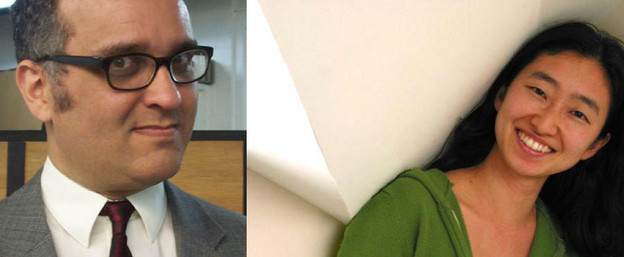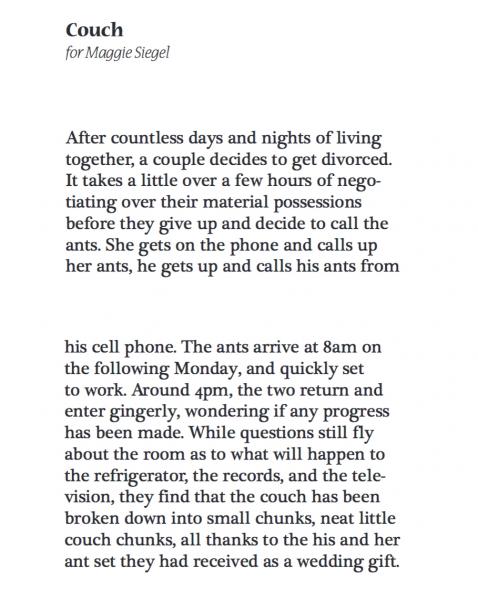
First reading of Sawako Nakayasu's 'Couch' (2)
K. Silem Mohammad

I try instinctually to fit the poem into the literary contexts I’m familiar with, and to ask questions about those contexts: in this case, domestic fiction and its stylistic markers (why the generic anonymity of the couple?), the dream/vision tradition (am I supposed to view this through the same kind of lens, perhaps a psychoanalytic one, through which I would view a report of an actual dream?), and the inescapable implication of allegory (what is the “something else” I am supposed to arrive at via the poem? what do the ants represent? the couch itself? or is the appearance of allegorical significance illusory, a feint?). Actually, all these questions relate to allegory or its core trope of metaphor, to the idea that when we read about something strange and unfamiliar in a literary context, we are in fact reading about something familiar in a transformed guise. What makes this approach interestingly inadequate here is the refusal of the poem to make any firm suggestions about how we are supposed to bring the unfamiliar and familiar together. The specifics of certain images are arbitrary and vague in a way that is both frustrating and exciting. What do “neat little couch chunks” look like? Are they shaped like little couches? Do the ants use these little couches to sit on? Should I even be thinking about things like this, or is the poem revealing my imagination as childish, banal? There are other “dead ends” of this sort. For instance, I spend what feels like a little too much time trying to decide if it means anything that two words in the first sentence of the poem start with the letters cou, echoing the titular couch. There is no indication that this is the type of poem in which wordplay like this would matter, but my eye lands on it anyway. And then, why does it appear that the woman calls her ants from a landline and the man calls his from a cell phone? Why is it important what time the ants arrive, and what time the man and woman drop back in? Why is the couch the center of focus, above all the other things in the couple’s home? The detail that feels the most like a telling “clue” is the “his and her ant set” the couple “had received as a wedding gift”: my attempts to construct a logic for this detail bring me to a scenario in which the couple’s wedding gift deliberately anticipates their dissolution, in which the system prepares itself consciously, via cultural cooperation, for its own breakdown. But this is just one of many possible paths my reading might take, and it doesn’t feel definitive. That I can’t ever settle on a “proper” symbolic interpretation of the ants keeps me from settling into an apathetic satisfaction with my critical take. Having read Nakayasu’s poems involving ants off and on over the past few years, I always reencounter these ants with a sense of uncanny recognition, as though they were actual ants crawling on my armhairs. I feel as though her work will eventually reveal itself as a mountain of ants eating through everything, a massive army of ants that must have been there for a long time but we’re only just now noticing it. And then, will we feel compelled to exterminate them, or will they suggest a new social order, parallel to our own or in place of it, to which we’ll just need to adjust?

from Sawako Nakayasu, Insect Country [PDF]
K. Silem Mohammad is the author of several books of poetry, including Deer Head Nation (2003), A Thousand Devils (2004), Breathalyzer (2008), and The Front (2009). In The Sonnagrams (2009), Mohammad anagrammatizes Shakespeare’s sonnets into all-new English sonnets in iambic pentameter. He is also editor of the poetry magazine Abraham Lincoln and faculty editor of West Wind Review. He teaches English and Writing at Southern Oregon University.